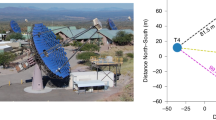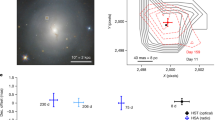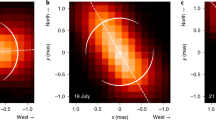Abstract
IT has been shown by Hanbury Brown and Twiss1–3 that the correlation between the fluctuations in the outputs of two photo-electric detectors illuminated by a source of finite size depends on the angular distribution of brightness over the source. Measurement of the variation of this correlation with separation of the two detectors thus provides a method of measuring the angular diameters of bright stars. An experimental interferometer in which the photo-electric detectors were situated at the foci of two searchlight mirrors was constructed at Jodrell Bank in 1956 and successfully tested on Sirius4,5. Following this work a large instrument was designed to measure all the stars in the Southern Hemisphere of spectral type earlier than FO which are brighter than photographic magnitude + 2.5. The new instrument differs chiefly from the pilot model4 in having mirrors of diameter 22 ft. moving on a circular railway track of diameter 618 ft. corresponding to a maximum resolution of the order of 0.0005 sec. This stellar intensity interferometer6, which will be described in detail elsewhere, is at present nearing completion at the Narrabri Observatory of the Chatterton Department of Astronomy of the School of Physics, University of Sydney.
This is a preview of subscription content, access via your institution
Access options
Subscribe to this journal
Receive 51 print issues and online access
$199.00 per year
only $3.90 per issue
Buy this article
- Purchase on Springer Link
- Instant access to full article PDF
Prices may be subject to local taxes which are calculated during checkout
Similar content being viewed by others
References
Hanbury Brown, R., and Twiss, R. Q., Proc. Roy. Soc., A, 242, 300 (1957).
Hanbury Brown, R., and Twiss, R. Q., Proc. Roy. Soc., A, 243, 291 (1957)
Hanbury Brown, R., and Twiss, R. Q., Proc. Roy. Soc., A, 248, 199 (1958).
Hanbury Brown, R., and Twiss, R. Q., Nature, 178, 1046 (1956).
Hanbury Brown, R., and Twiss, R. Q., Proc. Roy. Soc., A, 248, 222 (1958).
Messel, H., Nature, 186, 270 (1960).
Allen, C. W., Astrophysical Quantities (Athlone Press, 1963).
Willstrop, R. V., Mon. Not. Roy. Astro. Soc., 121, 17 (1960).
Stebbins, J., and Kron, G. E., Astrophys. J., 126, 266 (1957).
Popper, D. M., Astrophys. J., 129, 647 (1959).
Johnson, H. L., and Morgan, W. W., Astrophys. J., 117, 313 (1953).
Bless, R. C., Astrophys. J., 132, 532 (1960).
Jenkins, L. F., General Catalogue of Trigonometric Stellar Parallaxes (Yale University Observatory, 1952).
Author information
Authors and Affiliations
Rights and permissions
About this article
Cite this article
BROWN, R., HAZARD, C., DAVIS, J. et al. A Preliminary Measurement of the Angular Diameter of α-Lyrae. Nature 201, 1111–1112 (1964). https://doi.org/10.1038/2011111a0
Issue Date:
DOI: https://doi.org/10.1038/2011111a0
This article is cited by
-
Applications of interferometers in space to astrometry and planetary detection
Celestial Mechanics (1980)
-
Brightness Distribution of Antares from Lunar Occultations
Nature (1966)
Comments
By submitting a comment you agree to abide by our Terms and Community Guidelines. If you find something abusive or that does not comply with our terms or guidelines please flag it as inappropriate.



